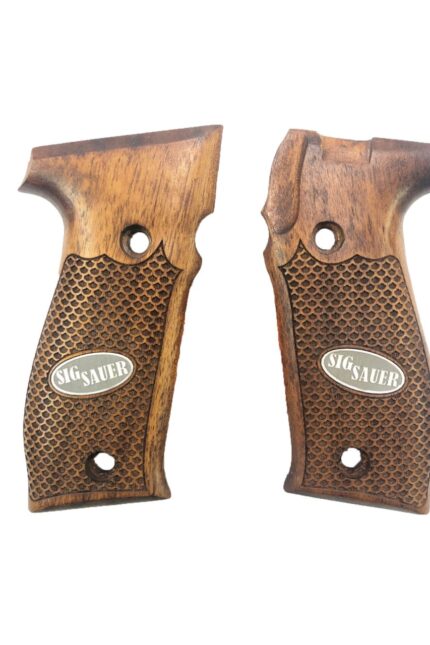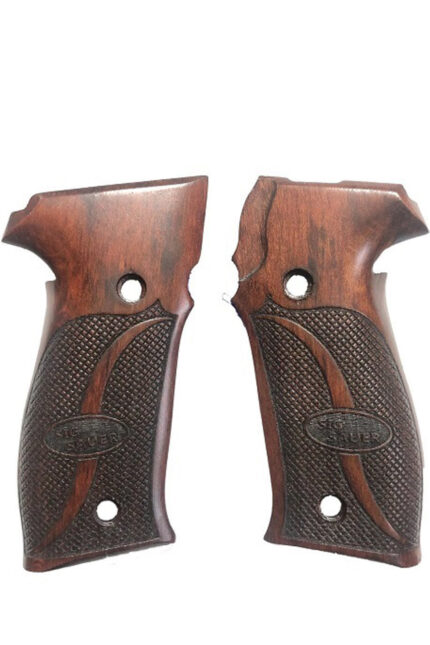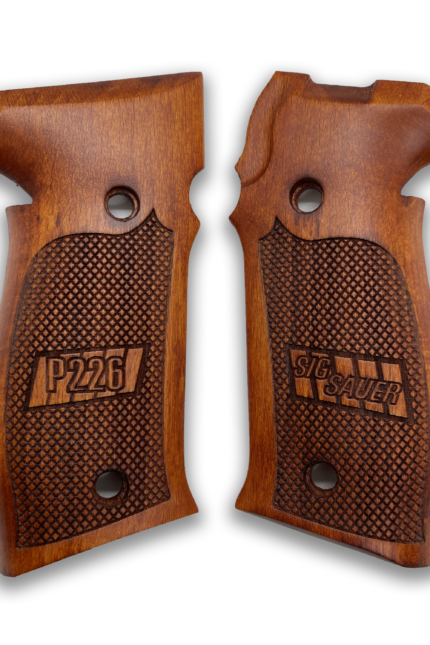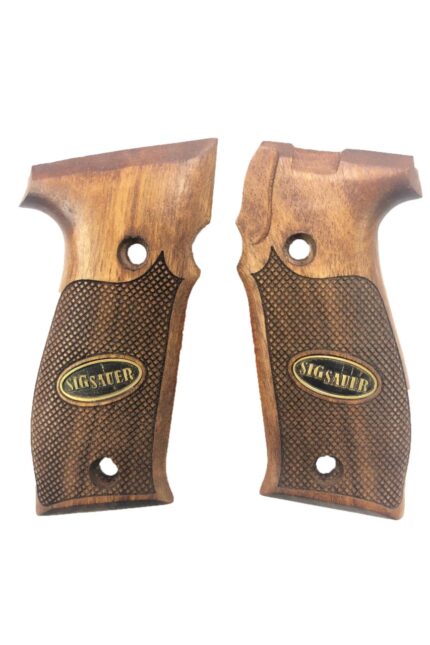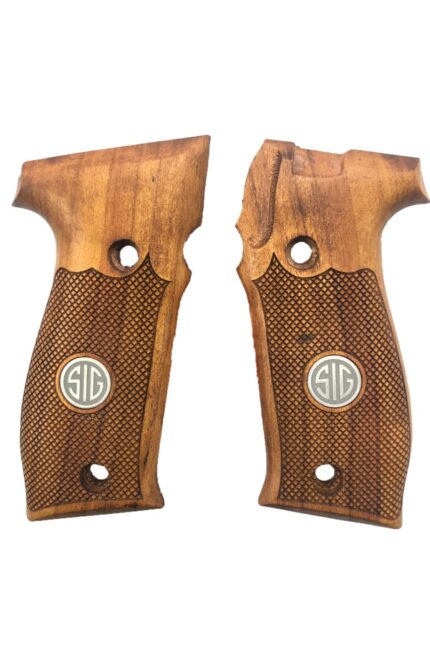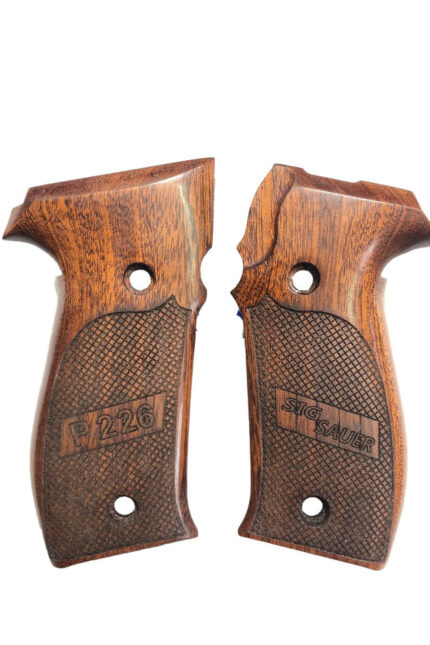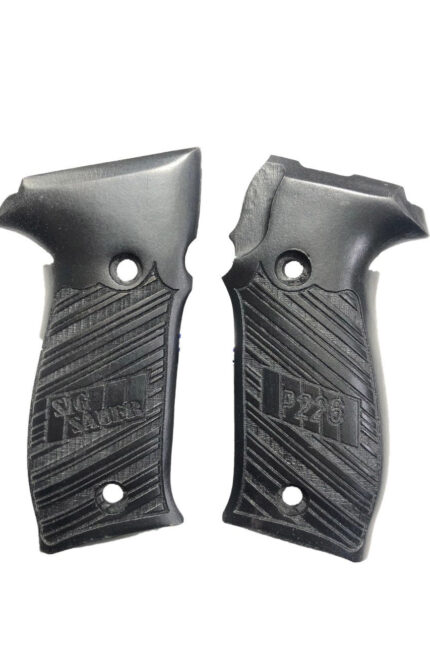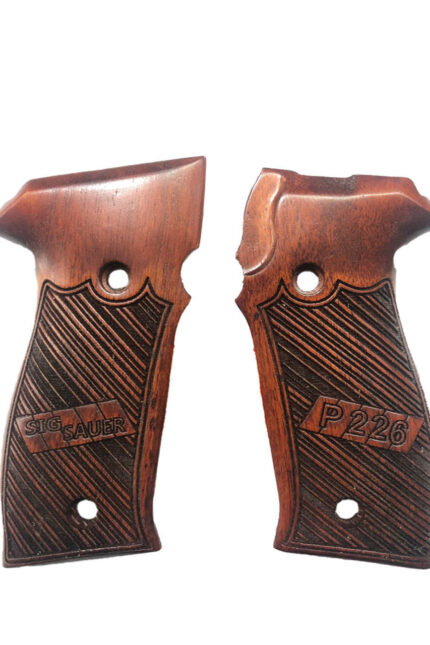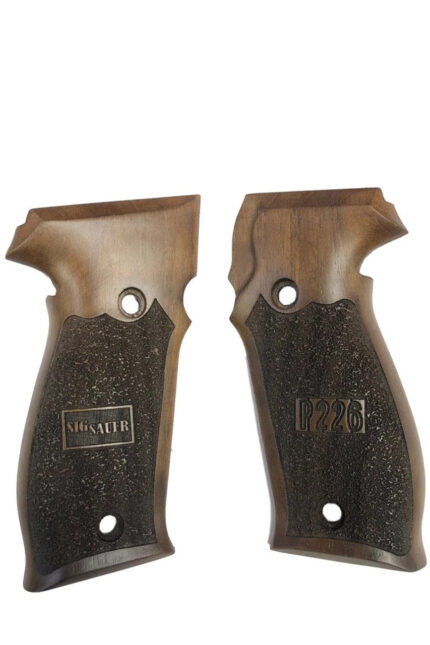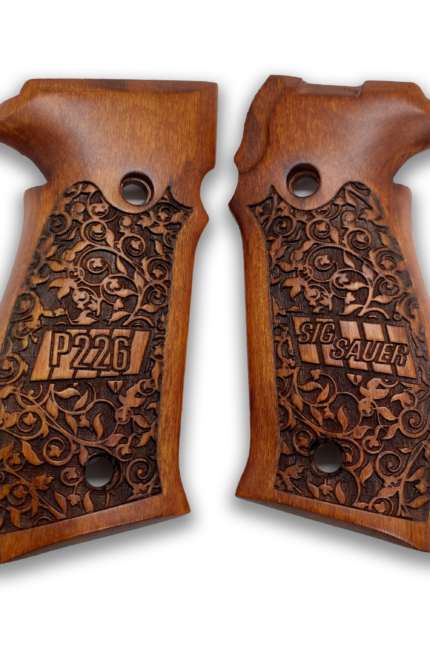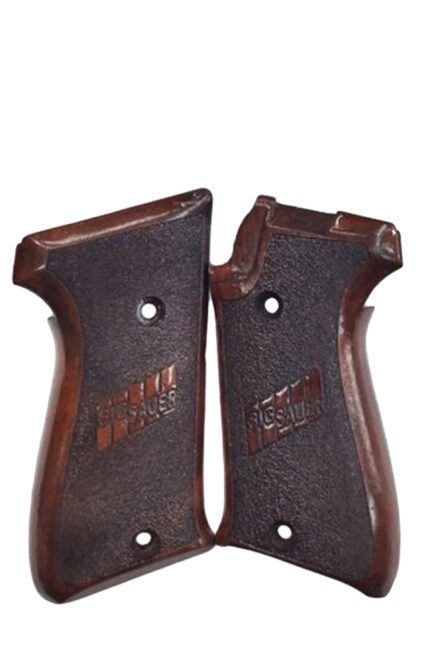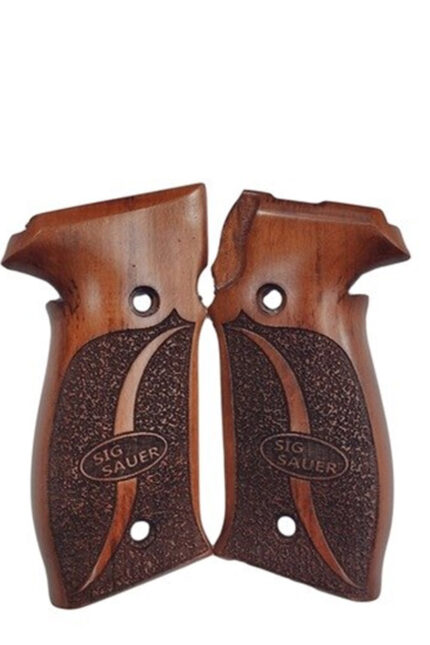Showing 1–12 of 34 results
Categories
Compatible Models
Color
- Natural Wood 18
Material
- Beech wood 18
Logo
- Without Logo 18
Laser Engraver
- Yes 18
Heat Treated
- Yes 18
Load more products
Loading...
Introduction to Target Shooting with the Sig Sauer P226: Tips and Techniques
The Sig Sauer P226 is renowned for its exceptional accuracy, reliability, and smooth handling, making it a favorite among law enforcement, military, and shooting enthusiasts worldwide. This guide is dedicated to exploring targeted shooting techniques that can leverage the superior design of the P226 to enhance your precision and effectiveness on the range. Whether you are training for competition, honing your tactical skills, or simply enjoying recreational shooting, the tips and techniques outlined here will help you master the art of shooting with one of the most iconic pistols. We will delve into fundamental shooting principles, advanced targeting strategies, and the best customizations and practices to ensure that every shot with your Sig Sauer P226 is executed with confidence and precision. Join us as we unlock the full potential of the P226, helping you achieve tighter groupings and more consistent performance in every firing session.
Basic Shooting Principles with Sig Sauer P226
Mastering the Sig Sauer P226 starts with a solid understanding of the basic shooting principles. This robust and precise firearm demands attention to detail in handling, which significantly impacts accuracy and performance.
Proper Stance and Grip Techniques
The way you hold and position your body with the Sig Sauer P226 can greatly affect your shooting accuracy:
- Stance: Adopt a comfortable and stable shooting stance that allows you to remain balanced while shooting. The stance should enable quick movement without sacrificing stability. Whether you prefer the isosceles or Weaver stance, ensure that your body is well-aligned with the target.
- Grip: The grip is critical in controlling recoil and maintaining accuracy. Utilizing Sig Sauer P226 grips tailored for your hand size can make a significant difference. For those who prefer a traditional aesthetic and feel, Sig Sauer P226 wooden grips offer a classic look with reliable performance. For optimal customization, consider the best Sig Sauer P226 custom grips available, which are designed to enhance the natural ergonomics of your hand positioning, improving control and comfort.
Trigger Control and Breathing Techniques
Effective trigger control and proper breathing are paramount for precision shooting:
- Trigger Control: Smooth and consistent trigger pressure is key to maintaining accuracy. The Sig Sauer P226's trigger is designed for sharp, responsive action. Practice pulling the trigger straight back with just enough pressure to release it without jerking the gun.
- Breathing: Proper breathing helps stabilize your hand and enhance focus. Inhale deeply and exhale partially, then hold your breath as you squeeze the trigger to minimize body movement.
Sight Alignment and Sight Picture
Correctly aligning the sights is crucial for hitting the target:
- Sight Alignment: The Sig Sauer P226 comes equipped with high-quality sights that are designed for easy alignment. Focus on aligning the front sight evenly between the notch of the rear sight while keeping the front sight in sharp focus.
- Sight Picture: Once the sights are aligned, the sight picture—how the target appears in relation to the sights—should be clear. Practice maintaining a consistent sight picture as you shoot to improve your accuracy over time.
Advanced Shooting Techniques with Sig Sauer P226
Building on the basic principles, advanced techniques focus on improving speed and accuracy under various shooting conditions, particularly when engaging multiple targets or shooting at longer distances.
Rapid Target Acquisition and Transitions
The ability to quickly locate and accurately hit multiple targets is crucial in many shooting disciplines:
- Fast Sight Re-engagement: Practice quickly re-focusing on the front sight after each shot to reduce time between shots. The Sig Sauer P226 is particularly well-suited for this with its superior ergonomics and balance.
- Transitional Drills: Implement drills that require shifting focus between multiple targets at different distances and angles. Use a combination of static and moving targets to simulate realistic scenarios. Transitioning effectively requires not only quick sight alignment but also controlled, swift movements that maintain accuracy.
Enhancing Accuracy During Shooting
Maintaining precision while increasing speed is a skill that requires practice and fine-tuning:
- Follow-Through: Even after the shot is fired, maintaining focus on your sight picture is crucial. Follow-through ensures that the gun is stable and your body and mind are ready for the next shot.
- Adjusting for Recoil: The Sig Sauer P226, especially with customized grips like the best Sig Sauer P226 custom grips, can help manage recoil. Learn to anticipate and counteract the recoil by adjusting your grip and stance to maintain target alignment.
Utilizing Modern Shooting Aids
Incorporating technology can also enhance your shooting skills:
- Electronic Sights: Consider using red dot sights or holographic sights on your Sig Sauer P226. These can speed up target acquisition and improve accuracy in rapid-fire or low-light conditions.
- Performance Enhancing Accessories: Explore other accessories like enhanced triggers and custom magazine releases, which can further refine your shooting experience and performance.
H4: Systematic Practice and Evaluation
Regular practice sessions coupled with systematic evaluation help in solidifying these advanced skills:
- Regular Range Sessions: Schedule consistent training sessions to practice these techniques. Use a timer to track improvements in speed and accuracy.
- Skill Assessment: Regularly assess your progress by setting benchmarks and recording performance during drills. Adjust your training focus based on areas that need improvement, ensuring a well-rounded skill set.
Customizations and Upgrades for Sig Sauer P226
Customizing your Sig Sauer P226 can significantly improve its functionality, aesthetics, and overall shooting experience. We will explore various upgrade options that can be tailored to enhance precision, handling, and comfort.
Optics and Sighting Systems
Enhancing your Sig Sauer P226 with advanced optics can transform your shooting accuracy, especially in varied lighting conditions:
- Red Dot Sights: Installing a red dot sight on your Sig Sauer P226 can help with faster target acquisition and improved shot accuracy, essential for both competitive shooting and tactical operations.
- Laser Sights: For low-light conditions, a laser sight can be invaluable. It provides a clear aiming point that is quick to align and easy to maintain, even under stress.
Trigger and Accessory Upgrades
The right trigger system and additional accessories can make a significant difference in how your firearm performs:
- Trigger Upgrades: Replacing the factory trigger with a lighter, crisper aftermarket option can reduce pull weight and reset length, which enhances shooting precision and comfort.
- Custom Grips: As previously discussed, Sig Sauer P226 custom grips are not just about improving aesthetics; they can also enhance grip stability and comfort, making the firearm an extension of the shooter’s hand. Opt for grips that suit your hand size and texture preference to improve control and fatigue reduction.
Enhancing Reliability and Performance
Modifications aren’t only about external additions but also internal enhancements:
- Enhanced Recoil Springs: Upgrading the recoil spring system can help manage the recoil better, making follow-up shots faster and more accurate.
- Magazine Extensions: For those who use their Sig Sauer P226 in competitive shooting, extended magazines can increase capacity and improve handling during quick reloads.
Maintenance and Care Post-Customization
With customizations come the need for adjusted maintenance routines:
- Regular Inspections: Post-modification, it’s crucial to regularly inspect your firearm to ensure all custom parts are functioning correctly and are properly maintained.
- Professional Installation: For complex modifications like internal upgrades or precision optics, professional installation is recommended to ensure optimal functionality and safety.
Training Drills with Sig Sauer P226
Implementing focused training drills is crucial for mastering your Sig Sauer P226, especially after making any customizations. These drills are designed to improve your familiarity with the firearm, enhance your shooting accuracy, and increase your confidence in handling different scenarios.
Practice Routines and Tips
Effective practice routines are foundational for integrating new techniques and ensuring consistent performance:
- Daily Quick Draw Practice: Regularly practice drawing your Sig Sauer P226 from a holster to improve your speed and fluidity. This is crucial for tactical and self-defense scenarios where reaction time is critical.
- Accuracy Drills: Set up targets at varying distances and practice shooting with the aim of tightening your shot group. Utilize your upgraded sights or optics to focus on precision, which will help you get accustomed to the new configurations.
Performance Evaluation and Improvement
Continuously assess your shooting performance to identify areas for improvement:
- Timed Drills: Incorporate timed shooting drills to not only improve speed but also to maintain accuracy under pressure. This can be especially beneficial in competitive shooting environments.
- Record Keeping: Maintain a logbook of your training sessions, noting the outcomes and any adjustments made during the session. This documentation can help you track your progress over time and pinpoint areas that need more focus.
Engaging Multiple Targets
Moving beyond static shooting to engaging multiple targets effectively:
- Transition Techniques: Practice engaging multiple targets in succession to improve your target transition speeds. This drill helps in building muscle memory for quick sight realignment and shooting after each movement.
- Use of Cover and Movement: Implement scenarios that require moving between cover points while engaging targets. This adds a layer of complexity and realism to your training, simulating real-life conditions.
Advanced Scenario-Based Training
Finally, integrating more complex scenarios ensures readiness for any situation:
- Stress Shooting: Train under simulated stress conditions, such as low-light environments or with noise distractions, to prepare for adverse situations.
- Tactical Reload Drills: Practice reloading under time constraints to improve efficiency and ensure you can maintain firepower when it counts most.
Throughout this guide, we've explored the comprehensive range of techniques, customizations, and training drills designed to maximize the potential of your Sig Sauer P226. From basic shooting principles to advanced tactical maneuvers and performance-enhancing modifications, each segment has been crafted to provide you with actionable insights and practical advice tailored for both novice and experienced shooters alike. Our goal has been to equip you with the knowledge and skills necessary to enhance your precision, speed, and effectiveness in using your Sig Sauer firearm.
As you continue to hone your skills and optimize your firearm, remember that zibgrips.com is your ultimate resource for high-quality Sig Sauer accessories and expert advice. Whether you are looking to upgrade your grips, sights, or explore other custom options, our extensive catalog and knowledgeable staff are here to support your journey towards shooting excellence. Visit zibgrips.com today to discover how our products and expertise can help elevate your shooting experience, ensuring that every pull of the trigger is as rewarding as it is effective. Let us help you transform your Sig Sauer into the perfect tool for your shooting needs, tailored precisely to your personal style and requirements. Connect with us and take your Sig Sauer P226 to its fullest potential.
What are 1911 Grips: Their Importance for Your Firearm
Understanding the Role of 1911 Grips in Firearm Ergonomics
1911 grips are more than just a part of your handgun; they are crucial for ensuring optimal control and stability during use. These grips, often made from a variety of materials, including the popular 1911 wooden grips, allow for a better grasp and significantly reduce the risk of slippage. Whether you're using your firearm for competitive shooting or self-defense, the right grips can enhance both performance and comfort.
The Aesthetic Impact of 1911 Grips on Your Firearm
Besides functionality, 1911 grips also play a pivotal role in customizing the appearance of your firearm. With best 1911 custom grips, gun owners have the opportunity to personalize their weapon to reflect their style and preferences. This customization not only makes your firearm more unique but also can increase its overall value.
In summary, 1911 grips are essential for both the functional ergonomics and aesthetic customization of your firearm. Choosing the right type of grip, such as the 1911 wooden grips, can transform the shooting experience by providing both a secure hold and a personal touch to your firearm.
Benefits of Custom 1911 Grips
Enhanced Shooting Accuracy with Custom Grips
Customizing your 1911 grips not only elevates the look of your firearm but also enhances your shooting accuracy. Tailored grips fit perfectly into the palm of your hand, allowing for more precise control over the firearm. This precision is particularly crucial during competitive shooting or high-stress situations where every millisecond counts.
Improved Comfort and Reduced Fatigue
Another significant advantage of using best 1911 custom grips is the improved comfort they provide. Custom grips are designed to align with the natural contours of your hands, reducing the strain on your fingers and wrist during prolonged use. This ergonomic benefit helps in minimizing fatigue and maintaining a steady hand for longer periods.
Durability and Longevity of Materials
Choosing high-quality materials for your 1911 grips can greatly increase the durability and longevity of your firearm. Materials like premium wood or advanced polymers are not only robust but also resistant to environmental factors such as moisture and temperature changes. Investing in 1911 wooden grips made from superior materials ensures that your firearm remains reliable and functional over time.
In conclusion, the benefits of customizing your 1911 grips extend far beyond aesthetics. They contribute to a more accurate, comfortable, and durable shooting experience, making them an essential consideration for any firearm enthusiast.
Best Materials for 1911 Grips
Exploring Popular Materials for Enhanced Performance
When it comes to customizing 1911 grips, the choice of material can significantly affect both the functionality and aesthetics of your firearm. Some of the most popular materials include wood, synthetic polymers, and metals. Each material offers distinct advantages, such as the warmth and classic beauty of 1911 wooden grips that appeal to traditionalists and collectors alike.
The Benefits of Wooden Grips
Wood is prized for its natural texture and the ability to carve intricate designs into it. High-quality woods like walnut or mahogany not only enhance the visual appeal but also provide a durable grip that ages gracefully with your firearm. These 1911 wooden grips are perfect for those who value craftsmanship and a timeless look.
Synthetic and Composite Materials: Modern Alternatives
Synthetic grips, made from materials like G10 or rubber, offer modern shooters a variety of textures and colors. These materials are engineered to withstand harsh conditions without deteriorating, making them ideal for tactical use. They also tend to be lighter than metal or wood, which can help reduce the overall weight of the firearm.
Metal Grips for Durability and Precision
Metal grips, often crafted from aluminum or stainless steel, offer unmatched durability and a sleek, modern aesthetic. They are especially favored in competitive shooting for their ability to add heft and stability to the firearm, aiding in recoil management and improving shot consistency.
Choosing the right material for your 1911 grips is crucial in enhancing both the performance and appearance of your firearm. Whether you prefer the classic elegance of wood, the resilience of synthetics, or the modern touch of metal, each material provides unique benefits that cater to different shooting styles and preferences.
Considerations When Choosing 1911 Grips
Assessing Grip Size and Hand Fit
One of the most crucial factors to consider when selecting 1911 grips is how well they fit in your hand. Not all hands are the same size or shape, and choosing a grip that complements your hand's unique characteristics can greatly enhance control and comfort. It's important to try different sizes and shapes to see what feels most natural and provides the best support during shooting.
Style and Personal Preference
While functionality is key, the style of the grip should also reflect your personal taste. Whether you prefer the classic look of 1911 wooden grips or the more modern appeal of tactical synthetics, the appearance of your grips can significantly enhance your firearm's overall aesthetic. Remember, the style you choose not only affects how you feel about your weapon but can also influence your confidence and performance.
Environmental Considerations
The environment in which you use your firearm also plays a significant role in choosing the right grips. For those frequently exposed to wet conditions, materials that provide better grip even when wet, like rubber or textured polymers, might be ideal. Conversely, if you're often in dusty or sandy environments, you might prefer grips that are easy to clean and maintain.
Long-Term Durability and Maintenance
Finally, consider the durability and maintenance requirements of different grip materials. Some materials, like high-quality woods and metals, might require more care to maintain their appearance and functionality over time. Synthetic materials often offer ease of maintenance but check for quality to ensure they can withstand years of use without degrading.
1911 grips involves a careful balance of functional fit, aesthetic preference, environmental suitability, and long-term durability. By considering these aspects, you can select grips that not only improve the performance and look of your firearm but also cater to your specific needs and conditions.
Installing 1911 Grips: A Step-by-Step Guide
Preparing Your Firearm for Installation
Before beginning the installation of your 1911 grips, it is crucial to ensure that your firearm is unloaded and safe to handle. Check the chamber and the magazine to make sure they are both clear. Once safety is confirmed, you can proceed with disassembling the necessary parts of your firearm to replace the grips.
Tools Needed for Grip Installation
To install new grips on your 1911, you will typically need a few basic tools: a screwdriver that fits the grip screws, possibly an Allen wrench depending on the grip design, and a small hammer for any adjustments. Having the right tools at hand will make the installation process smoother and prevent damage to your new grips or firearm.
Step-by-Step Installation Process
- Remove the Old Grips: Using the appropriate screwdriver, remove the screws from the current grips. Carefully lift the grips away from the frame, being mindful of any washers or small parts.
- Clean the Grip Area: With the old grips removed, clean any debris or buildup from the grip area. This ensures a clean contact surface for the new grips, which can improve fit and prevent slippage.
- Align the New Grips: Place your new 1911 grips onto the frame. Ensure that all holes and cutouts align properly with the mounting points and controls on the firearm.
- Secure the Grips: Attach the new grips using the screws you removed earlier or new ones if provided. Tighten the screws evenly but do not over-tighten, as this could damage the grips or the firearm's frame.
- Check Functionality: Once the grips are installed, reassemble your firearm and perform a function check to ensure that all parts are working correctly and that the grips are securely attached.
Post-Installation Tips
After installing your new grips, it's a good idea to spend some time handling your firearm to get accustomed to the feel of the new material and shape. If any adjustments are needed, it's better to address these sooner rather than later to ensure optimal comfort and functionality.
Installing 1911 grips is a straightforward process that can significantly enhance the handling and aesthetics of your firearm. With the right tools and careful attention to detail, you can successfully customize your 1911 to better meet your shooting needs and personal style.
Frequently Asked Questions and Answers
Can I install 1911 grips on my own, or should I have a professional do it?
Installing 1911 grips can generally be done by most firearm owners using basic tools. As outlined in the previous guide, with the right tools and careful attention, you can install your grips at home. However, if you are not confident in your ability to safely handle your firearm, it is advisable to seek professional help.
How often should I replace my 1911 grips?
The frequency of replacing your grips depends on the material and how extensively you use your firearm. 1911 wooden grips, for example, may last many years with proper care. Regular inspections for wear and tear can help you determine when a replacement is necessary.
Are there any legal considerations for customizing grips?
In most regions, customizing grips is legally permissible as it does not alter the fundamental mechanics of the firearm. However, it is always best to check local laws and regulations to ensure compliance.
How do I choose the best material for my 1911 grips?
As discussed in earlier sections, the best material for your 1911 grips will depend on your specific needs and preferences. Consider factors like durability, comfort, aesthetic preference, and environmental conditions when choosing grip materials.
Can changing grips affect the resale value of my firearm?
Yes, changing grips can affect your firearm's resale value. High-quality, well-maintained grips, especially custom or designer ones, can increase the value, while poor-quality grips might decrease it. Always choose grips that enhance both the functionality and appearance of your 1911.
Throughout this comprehensive guide on 1911 grips, we've explored various aspects from their crucial role in enhancing firearm control and aesthetics to the detailed steps involved in selecting and installing them. Custom 1911 grips not only improve the functionality and appearance of your firearm but also offer an opportunity to express personal style and preference.
By understanding the importance of material choice, fitting the grip to your hand, and the aesthetic impact, you can significantly enhance your shooting experience. Remember, whether you opt for the classic elegance of 1911 wooden grips or the modern resilience of synthetic options, each choice plays a pivotal role in your firearm's performance and your satisfaction as an owner.
For those interested in exploring a wide range of custom grip options, or if you require assistance in choosing the right grips for your 1911, visit 1911 pistol grips. Here, you can find expert advice and a curated selection of high-quality grips designed to meet the needs of both casual shooters and competitive marksmen alike. For bulk purchases or more detailed inquiries, feel free to contact us via email at [email protected] or call our support line at +1 917 565 83 06.
Enhance your firearm today with the perfect set of 1911 grips and experience the difference in control, comfort, and customization.

